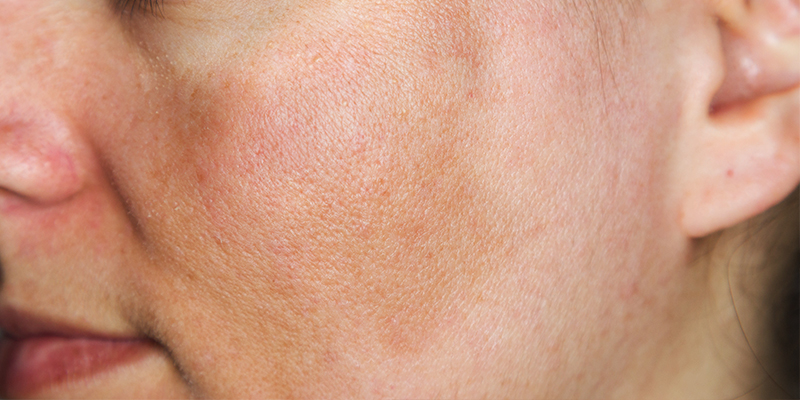What Is Nevus Depigmentosus And How To Treat It?
While increased pigmentation in certain areas of the body is a common concern, depigmentation is also a skin issue that can raise worry and stress levels when you want to get rid of the white patches. Nevus depigmentosus is a depigmentation skin condition that can be seen in babies and adults. The lighter skin patch appears prominently and can even be mistaken for vitiligo. Differential diagnosis to accurately identify nevus achromicus can help decide the course of action to be taken to induce pigmentation in the affected area.
What Is Nevus Depigmentosus?
Nevus depigmentosus is also called as nevus achromicus. It is characterized by the presence of a hypopigmented (lighter than the surrounding skin) patch on the skin. This hypopigmented area is present from birth and has a segmental or linear pattern usually. The skin is lighter than the surrounding skin because of a disruption in the natural melanin production cycle. Melanin is a pigment produced by cells called melanocytes in the skin that impart the skin with its characteristic colour.
Must Read: How To Remove White Scars On Face?
Nevus Depigmentosus Vs Vitiligo Vs Nevus Anemicus
The main difference between vitiligo and nevus depigmentosus is that the former is an acquired skin condition whereas nevus depigmentosus is present from birth (congenital). Additionally, the size of nevus achromicus remains stable as the person ages and vitiligo can progress with age. The white patches formed due to vitiligo can spread to other areas of the body and cause depigmentation in larger areas at once.
Nevus anemicus is also a congenital skin condition like nevus achromicus but is caused due to a vascular anomaly. This means that abnormal blood vessels are responsible for causing the light or pale patch on the skin.
Types Of Nevus Depigmentosus
Nevus achromicus is classified into the following types –
- Localized nevus depigmentosus: Most common type that presents a single patch with ragged borders.
- Segmental nevus depigmentosus – Larger in size compared to localized type and has a midline demarcation.
- Linear nevus depigmentosus – Also called whorled or systematized type and has extensive patches that can be associated with mental disorders.
Must Read: Common Skin Diseases And Treatments
Nevus Depigmentosus Symptoms
- Depigmented patch of skin from birth
- Irregular borders
- Usually stable but can grow in size with age, at times
- Does not spread or cause more white patches on the skin
- Can have ‘splashed paint’ appearance
- Found on the face, neck, trunk, and body extremities
Causes of Nevus Depigmentosus
Impaired function of melanocytes (melanin producing cells) causes nevus depigmentosus. The melanocytes either produce lesser amounts of melanin or fail to transport the melanin produced to another type of cells found in the skin called keratinocytes. The melanin in the keratinocytes is expressed as one’s skin tone. The exact cause behind these impaired melanocytes is unknown.
Diagnosis of Nevus Depigmentosus
In 1976, a scientist by the name of Coup established the following criteria to diagnose this condition –
- White patches present at birth or develop during infancy
- Stable patches that do not spread with age
- No change in the texture or sensitivity in the white patch area
- No hyperpigmented border present
Wood lamp’s test, diascopy test, and pathological tests may also be prescribed by dermatllogist for accurate diagnosis.
Treatment Of Nevus Depigmentosus
To restore the pigmentation in this type of birthmark and make the patch blend more easily with the rest of the skin, the following treatment options are available at skin clinics and dermatological centers –
- Excimer Laser For Nevus Depigmentosus: This treatment is often used to get rid of vitiligo patches and it can also be used to treat nevus depigmentosus. The wavelength of the laser light used is 308 nm and the targeted area is exposed to the laser energy in a controlled environment. The low dose of the ultraviolet B radiation induces the production of melanin in the congenital nevus depigmentosus patch. Repigmentation occurs to make the white patch appear darker than before with each successive session until the desired pigmentation levels are obtained. It is a safe procedure that is performed using US FDA approved equipment to treat hypopigmentation, such as nevus achromicus
- PUVA Therapy: Psoralen Ultraviolet A (PUVA) light is used to stimulate melanin production in the skin affected by nevus depigmentosus. The psoralen component of the therapy makes the skin more sensitive to UV light so that appropriate results can be obtained for repigmentation with UVA light. The results obtained with PUVA therapy are above average with varying levels of pigmentation being induced in each patient
- Melanocyte Keratinocyte Transplantation: Melanocytes are extracted and separated from the unaffected areas of the body and transplanted onto the affected skin with the hope that they can cause repigmentation. The results have not been consistent with this treatment according to the clinical studies that have been performed
- Suction Blister Grafting: Another uncommon method used for treating nevus depigmentosus is suction blister grafting. Grafts of skin obtained by suction method from the healthy skin are grafted on the white patch and allowed to heal. Though the results obtained in clinical setting are promising, the practicality and cost of this treatment makes it a less viable option.
Must Read: How To Increase Melanin Production In Skin?
Nevus depigmentosus is a congenital skin condition that can affect the your psychology and cause social embarrassment due to high chances of it being present on the face, neck, and other noticeable locations. Even though it is a benign skin disorder, its treatment using cosmetic dermatological methods can boost confidence by making the hypopigmentation fade away so that it becomes unnoticeable.















